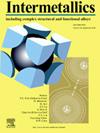Microstructure evolution in 3D-printed CoCrFeNi(AlTi)xwt% (x=0, 2.5, 5 and 7.5) high entropy alloys
IF 4.3
2区 材料科学
Q2 CHEMISTRY, PHYSICAL
引用次数: 0
Abstract
Applying 3D printing technology to high entropy alloys (HEAs) offers new potential for materials design and optimization. However, there is a lack of deep understanding of the microstructure evolution with the element addition to HEAs in 3D printing. How the element addition influences the final microstructure of materials during 3D printing still remains a puzzle. In this study, we investigated the microstructure evolution of CoCrFeNi(AlTi)xwt% (x = 0, 2.5, 5 and 7.5) HEAs fabricated by selective laser melting (SLM). We selected Al and Ti atoms as additions in the CoCrFeNi matrix based on their strong negative mixing enthalpy with Ni elements and larger atom radius than other matrix elements. It has been found that the Al and Ti addition leads to the formation of BCC and B2 precipitates, resulting in different mechanical properties. Yield strength (YS) of the HEAs exhibits a distinct increase from 512.64 MPa to 901.72 MPa at the cost of the ductility. The relationship between mechanical properties and microstructure evolution with Al and Ti additions has been elucidated. It has been found that the formation of a dislocation network in our HEAs serves as nucleation sites to benefit the precipitation. Besides, this network provides a rapid channel for atoms to diffuse during the thermal cycle of 3D printing, which also promotes the formation of precipitates. This research provides valuable insights into the modification of microstructure through SLM, contributing to the development of materials design and optimization in 3D printing.
三维打印 CoCrFeNi(AlTi)xwt%(x=0、2.5、5 和 7.5)高熵合金中的微观结构演变
将三维打印技术应用于高熵合金(HEAs)为材料设计和优化提供了新的潜力。然而,人们对三维打印技术在高熵合金中添加元素后的微观结构演变缺乏深入了解。在三维打印过程中,元素添加如何影响材料的最终微观结构仍是一个难题。在本研究中,我们研究了通过选择性激光熔融(SLM)制造的 CoCrFeNi(AlTi)xwt%(x = 0、2.5、5 和 7.5)HEA 的微观结构演变。我们选择 Al 原子和 Ti 原子作为 CoCrFeNi 基体中的添加物,是因为它们与 Ni 元素的混合焓为负,且原子半径大于其他基体元素。研究发现,Al 和 Ti 的加入会导致 BCC 和 B2 沉淀的形成,从而产生不同的机械性能。HEA 的屈服强度(YS)从 512.64 兆帕明显提高到 901.72 兆帕,但延展性却有所降低。研究还阐明了添加 Al 和 Ti 后机械性能与微观结构演变之间的关系。研究发现,在我们的 HEA 中形成的位错网络是有利于析出的成核点。此外,在三维打印的热循环过程中,这种网络为原子扩散提供了快速通道,这也促进了析出物的形成。这项研究为通过 SLM 改变微观结构提供了宝贵的见解,有助于三维打印中材料设计和优化的发展。
本文章由计算机程序翻译,如有差异,请以英文原文为准。
求助全文
约1分钟内获得全文
求助全文
来源期刊

Intermetallics
工程技术-材料科学:综合
CiteScore
7.80
自引率
9.10%
发文量
291
审稿时长
37 days
期刊介绍:
This journal is a platform for publishing innovative research and overviews for advancing our understanding of the structure, property, and functionality of complex metallic alloys, including intermetallics, metallic glasses, and high entropy alloys.
The journal reports the science and engineering of metallic materials in the following aspects:
Theories and experiments which address the relationship between property and structure in all length scales.
Physical modeling and numerical simulations which provide a comprehensive understanding of experimental observations.
Stimulated methodologies to characterize the structure and chemistry of materials that correlate the properties.
Technological applications resulting from the understanding of property-structure relationship in materials.
Novel and cutting-edge results warranting rapid communication.
The journal also publishes special issues on selected topics and overviews by invitation only.
 求助内容:
求助内容: 应助结果提醒方式:
应助结果提醒方式:


